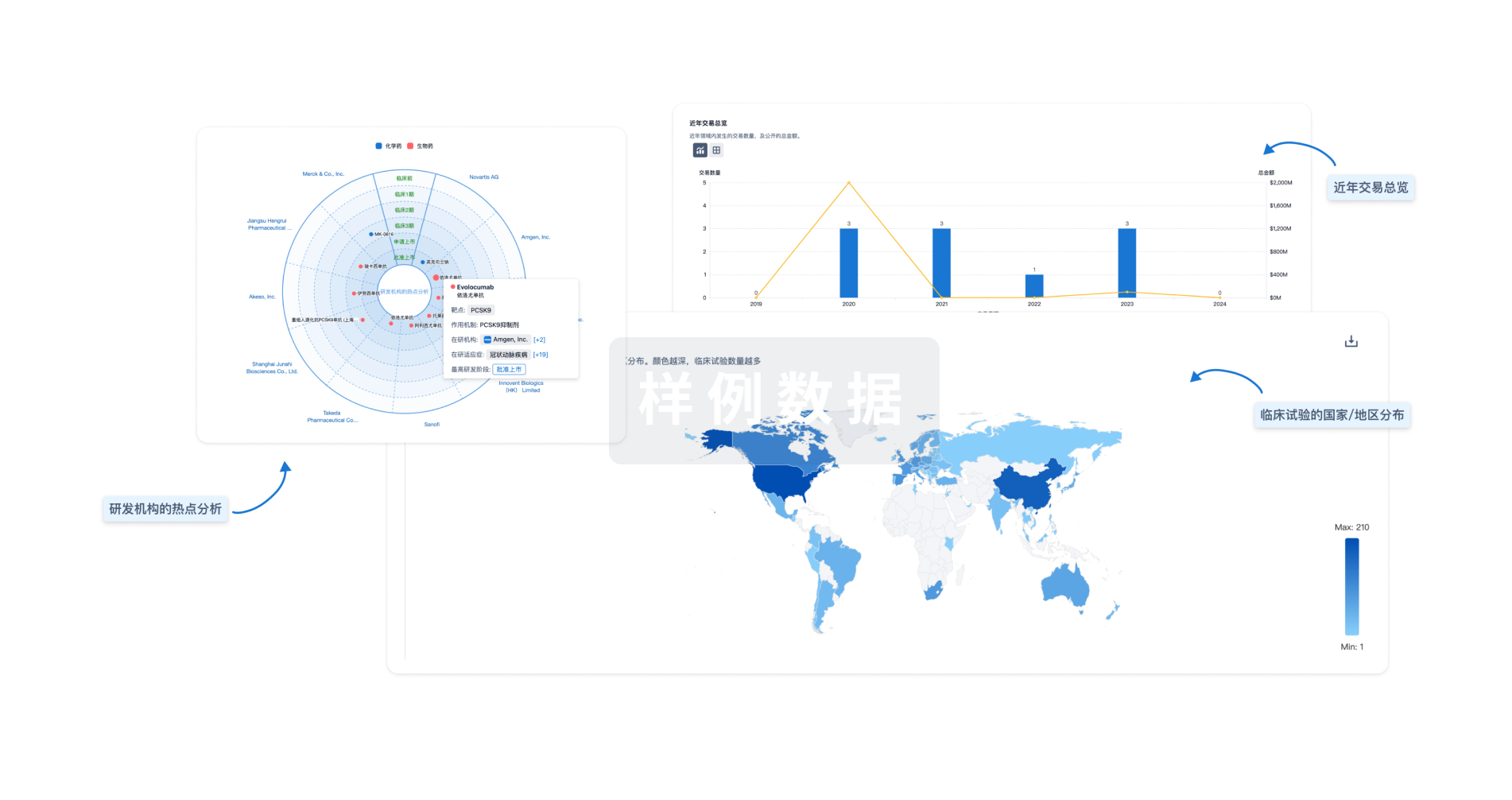预约演示
更新于:2025-05-07
FAP x PDL1
更新于:2025-05-07
关联
1
项与 FAP x PDL1 相关的药物作用机制 FAP拮抗剂 [+1] |
在研机构 |
原研机构 |
在研适应症 |
非在研适应症- |
最高研发阶段临床前 |
首次获批国家/地区- |
首次获批日期1800-01-20 |
100 项与 FAP x PDL1 相关的临床结果
登录后查看更多信息
100 项与 FAP x PDL1 相关的转化医学
登录后查看更多信息
0 项与 FAP x PDL1 相关的专利(医药)
登录后查看更多信息
44
项与 FAP x PDL1 相关的文献(医药)2025-04-01·Current Oncology Reports
Novel Clinical PET Tracers in the Pipeline for Melanoma
Review
作者: Aalbersberg, Else A ; Stokkel, Marcel P M ; Jaber, Nora ; Saadani, Hanna ; Schats, Winnie
2025-03-01·Cancer Letters
FAP upregulates PD-L1 expression in cancer-associated fibroblasts to exacerbate T cells dysfunction and suppress anti-tumor immunity
Article
作者: Liu, Fenglin ; Wei, Rongyuan ; Nomura, Sachiyo ; Liu, Xiaowen ; Liu, Chenchen ; Liu, Xuanjun ; Tsukamoto, Tetsuya ; Yamamoto, Masami ; Song, Junquan ; Zhao, Zhenxiong ; Wang, Yanong
2025-01-01·Journal for ImmunoTherapy of Cancer
FAP-targeted radioligand therapy with68Ga/177Lu-DOTA-2P(FAPI)2enhance immunogenicity and synergize with PD-L1 inhibitors for improved antitumor efficacy
Article
作者: Chen, Xiaoyuan ; Lin, Qin ; Zhou, Yangfan ; Sun, Long ; Chen, Haojun ; Zhao, Liang ; Fu, Kaili ; Pang, Yizhen ; Su, Guoqiang ; Wu, Hua ; Chen, Jianhao ; Luo, Qicong
59
项与 FAP x PDL1 相关的新闻(医药)2025-04-22
·小药说药
-01-引言目前,肿瘤免疫治疗已成为第三代肿瘤治疗中最活跃的研究领域。以PD-1、CTLA-4和PD-L1为靶点的免疫检查点抑制(ICI)疗法在多种癌症的治疗中显示出卓越的效果,并且ICI的免疫疗法随着新的免疫检查点的开发(如TIM-3、LAG-3和TIGIT)而继续扩大。然而,ICI治疗的主要目的是维持先前已建立的抗肿瘤活性。相比之下,刺激性免疫治疗靶点,如CD40、ICOS、CD27、GITR、OX40和4-1BB则用激动剂来激活免疫,主要集中在免疫反应的早期阶段。这些分子最先起作用的很可能是CD40,因为它在抗原呈递过程中起着关键作用,间接地激活T细胞。最新研究显示,CD40激动剂不仅可直接激活树突状细胞(DC)、B细胞等免疫“指挥官”,还能重塑肿瘤微环境(TME),甚至让“冷肿瘤”变得对免疫治疗敏感。CD40激动剂在癌症免疫治疗中正展现出巨大的潜力。-02-一、CD40/CD40L的表达为了获得强大而特异的免疫反应,固有免疫系统和适应性免疫系统需要在多个环节上进行协调。免疫反应的许多关键阶段是由肿瘤坏死因子超家族(TNFSF)的配体及其受体介导的,包括CD40/CD40L。抗原特异性T细胞的有效抗原识别关键取决于特异性抗原呈递细胞(APC)的存在和功能,如B细胞和DC细胞。这些APC通常在细胞表面表达共刺激表面受体CD40(TNFRSF5)。CD40是一种48kda大小的Ⅰ型跨膜蛋白,是连接固有免疫和适应性免疫的重要免疫细胞通讯介质。CD40存在于血小板、B细胞和髓系细胞,但也存在于非造血细胞,如内皮细胞、成纤维细胞、平滑肌细胞甚至某些类型的肿瘤细胞。CD40的同源配体是CD154(TNFSF5/CD40L),一种39kda的II型跨膜蛋白。CD40L的表达通常可诱导并局限于造血系统的细胞,如血小板、粒细胞、活化T细胞、活化B细胞和活化自然杀伤细胞(NK)细胞,但内皮细胞和平滑肌细胞也有弱表达。-03- 二、CD40/CD40L的结构、组成及信号通路TNFRSF信号传导的结构已经比较明确,需要恰当的三维受体聚集和三聚体化。虽然TNFSF配体天然以三价功能单位存在,但受体通常分散分布在细胞表面。TNFSF配体以同源三聚体的形式自然地聚集在细胞表面,其中三个受体结合位点位于相邻单体之间的三个完全相同的缝隙处。关键的是,受体组装成功能性的三聚体复合物是通过天然配体单元的结合发生的。这些三聚体TNFSF配体与在其他细胞表面表达的相应受体的相互作用导致了非常精确的受体聚集。配体对细胞外受体的指令传递给邻近的受体细胞内结构域,然后是细胞内信号复合物的有序组装。TNFSF配体的三聚体结构和由此产生的受体簇是信号传递到细胞的前提。由于这种特殊的要求,一价和二价的结构在体内通常被证明是极低效的。与TNFRSF的其他成员一样,CD40是一种膜结合分子,可以通过细胞间直接接触被膜结合配体激活,也可以被溶液中的可溶性配体激活。多种下游分子和细胞反应进程已被证明受到CD40结合的调节。同源配体连接受体可诱导形成空间上明确的三聚体信号复合物,促进TNF受体相关因子(TRAFs)和NFκB激活剂-1(Act1)的招募。信号复合物的特定组成,主要取决于细胞类型,触发各种途径。例如,与TRAF6的结合主要激活JAK/Stat3通路,TRAF1/2诱导MKK/p38/ERK1/2信号传导,Act1在NFkB通路、JNK和PI3K信号传导中具有多种功能,并与TRAF3一起放大MKK/p38/ERK1/2信号。此外,根据特定的环境,CD40结合可以激活“经典”和非典型的NFkB通路。-04-三、CD40/CD40L的生物学作用CD40在单核细胞及其子代巨噬细胞和DC细胞以及B细胞上的表达在发挥免疫细胞的功能中起着重要作用。单核细胞是固有免疫前体细胞,具有很高的可塑性。它们具有分化为多种细胞类型的能力,如巨噬细胞、髓源性抑制细胞(MDSC)和DC细胞。CD40信号是单核细胞成熟过程的重要触发因素,主要驱动分化为M1谱系的巨噬细胞和DC细胞。CD40与DC细胞表面的结合促进了细胞因子和趋化因子的产生,诱导共刺激分子的表达,并促进抗原的交叉呈递。CD40L的主要功能之一是通过激活DC细胞来增强抗原对T细胞的提呈。这一步称为“许可”,通过上调表面蛋白如CD54和CD86,增加DC与T细胞的相互作用,从而激活后者。B细胞也是CD40L活性的靶点。在胸腺中,T细胞和B细胞之间广泛的串扰使之必须维持表达CD40的B细胞,从而保持自体反应性T细胞对B细胞的阴性选择。B细胞与CD4+T细胞的直接相互作用诱导T细胞表达CD40L,进而保护B细胞不受凋亡的影响。在这个功能中,CD40L通过激活PI3K/Akt提供一个生存信号,使活化的B细胞维持寿命并向浆细胞分化。抗原特异性B细胞通过CD40的稳态增殖和生存机制是通过抗凋亡成员Bcl-2家族的上调来维持的。事实上,CD40/CD40L系统的缺陷与B细胞的抗体类别转换以及细胞超突变的缺陷(hyper-IgM综合征)有关。B细胞与活化的表达CD40L的T细胞的相互作用也增加了MHC-II和CD80或CD86等共刺激分子的表达,并诱导B细胞中的Ig类别转换。活化的B细胞迁移到淋巴器官,在那里向T细胞呈递抗原,CD40激活的DC和B细胞通过释放免疫刺激性细胞因子和趋化因子如IL-6、IL-12p70、IFNγ、CXCL10和TNFα来支持免疫应答。此外,CD40活化的B细胞能够通过促进TNFα和IFNγ等细胞因子的分泌来诱导抗原特异性CD8+T细胞。一些研究证明,体外活化的表达CD40的B细胞是完全功能性抗原提呈的B细胞,随后用这些细胞进行过继细胞转移(ACT)治疗可提高抗肿瘤的疗效。-05-四、CD40/CD40L与肿瘤免疫数十年来,CD40/CD40L信号传导同步免疫反应的固有、细胞和体液分支的非凡能力激发了基础和临床研究的灵感。鉴于CD40的一般表达谱和生物学活性,人们已经做了许多尝试来探索CD40/CD40L信号在抗肿瘤免疫中的作用。CD40激活的DC细胞可用于癌症和传染性疾病(如结核病)的疫苗治疗。CD40信号的另一个有趣结果是表型从“另类活化”的M2型向抗肿瘤或“经典活化”的M1型的转变。这种M1/M2型的命名与肿瘤相关巨噬细胞(TAM)在肿瘤免疫治疗中特别相关。所谓的M1型的“经典活化”巨噬细胞产生于对GM-CSF以及IFNγ和LPS等刺激物的反应,通常被认为具有促炎性免疫反应和抗原交叉呈递的作用。M1型巨噬细胞主要与良好的抗肿瘤免疫反应相关。“另类活化”的M2型巨噬细胞是由于暴露于M-CSF和细胞因子(如IL-4和IL-10)而产生的,并参与组织修复和消除炎症状态。肿瘤相关的M2型被认为是癌症进展和转移的关键驱动因素。肿瘤和浸润性巨噬细胞的紧密相互作用强烈地塑造了肿瘤微环境,从而建立了炎症或促肿瘤的局部条件。有人提出,改善肿瘤内M2/M1谱系的平衡可以通过促进细胞毒性T细胞的浸润和激活来提高抗肿瘤免疫反应。这一点已经在多个模型中进行了描述,例如胰腺癌和小鼠异种移植胶质母细胞瘤模型。巨噬细胞复极化与CD40活化诱导CD206下调和CD54表达增加一致,表明巨噬细胞迁移能力的改变和有效激活。有趣的是,尽管CD40在许多组织中广泛表达,肿瘤细胞似乎更易受膜结合CD40L诱导的CD40杀伤。在B16黑色素瘤小鼠模型中,DC细胞上表达的膜结合CD40L可直接诱导CD40阳性肿瘤细胞凋亡,而非T细胞依赖的的细胞生长抑制活性则源于CD40刺激的IFNγ激活的巨噬细胞。这一现象的部分原因可能不是CD40信号的直接作用,而是对易感细胞类型死亡受体的二次上调。然而,抗CD40抗体Lucatumumab和dacetuzumab对B细胞恶性肿瘤有一定的临床效果,这可能归因于抗体介导的巨噬细胞吞噬和抗体依赖性细胞毒性(ADCC)的作用。结合CD40后,肿瘤细胞显示出DNA损伤的迹象,分泌促血管生成因子,如VEGF和IL-8,并且通常表现出衰老相关分泌表型(SASP)的状态,这是由于CD40诱导的NFκB通路的激活。-06-五、CD40激动剂的药物开发现状基于其独特的受体聚集模式,从TNFRSF产生的下游信号依赖于具有非常精确的结构和三维组成的激动剂化合物。由于CD40在抗肿瘤免疫反应中发挥关键作用,诱导CD40信号的各种策略已经被广泛地研究探索。大致可分为基于激动剂抗体的方法或基于CD40L的方法。目前,临床开发中有9种激动性人抗CD40抗体:4种IgG1抗体(APX005M、mitazalimab、2141-V11、SEA-CD40),2种IgG2抗体(selicrelumab和CDX-1140),1种IgG突变抗体(LVGN7409)和2种双特异性抗体(RO7300490、ABBV-428)。SelicrelumabSelicrelumab(也称为CP-870893,RO7009789)是一种完全人IgG2抗体,不依赖于通过Fc结构域交联来激活CD40。selicrelumab是临床试验中研究最广泛的CD40激动剂。最近,一项1期研究评估了selicrelumab在胰腺导管腺癌(PDAC)患者手术前使用或不使用化疗(nab-紫杉醇和吉西他滨)的新辅助治疗(NCT02588443)。接受selicrelumab单药治疗的患者的1年OS率(中位数+SE)分别为81.8%+11.8%,接受selicreumab联合化疗的患者为100%。Selicrelumab耐受性良好,相关不良事件(AE)大多较轻。此外,发现了selicrelumab诱导TME调节的证据,包括T细胞浸润、DC成熟、巨噬细胞复极化和肿瘤基质密度降低。CDX-1140CDX-140是一种人IgG2单克隆抗体,可驱动NF-kB激活。它结合CD40L结合位点之外的结构域,其激活机制独立于FcR交联。来自评估CDX-1140与抗PD-1治疗(pembrolizumab)联合使用或不使用的I期试验的数据显示,1.5 mg/kg CDX-1140联合200 mg pembrolizumab的剂量具有良好的安全性。观察到临床益处,尤其是在非小细胞肺癌(NSCLC)患者中,有80%的可评估患者具有稳定疾病(SD),而所有患者在之前的基于抗PD-1/L1的治疗中都经历了进展性疾病(PD)(NCT03329950)。APX005MAPX005M是一种人源化IgG1单克隆CD40抗体。通过Fc结构域中的点突变,APX005M增强了与FcγRIIb的结合亲和力,促进了CD40的交联并介导了ADCC。多个早期临床试验评估了APX005M与免疫疗法的联合应用。一项II期研究评估了APX005M与化疗(nab-paclitaxel和吉西他滨)联合使用或不使用抗PD-1(nivolumab)治疗转移性胰腺癌患者的疗效。研究表明,APX005并没有显著改善OS:在105名患者中,nivo/化疗达到了1年总生存期(OS)的主要终点,但APX005M/化疗或APX005M/Cnivo/化学均未达到。然而,APX005M/化疗后的存活率与更显著的肿瘤内CD4+T细胞浸润、循环分化的CD4+T细胞和APCs相关(NCT03214250)。最近,在随后的一项II期研究中,研究了APX005M与纳武单抗联合治疗抗PD-1疾病进展后的转移性黑色素瘤患者。客观反应率(ORR)为15%,中位反应持续时间至少为26个月。MitazalimabMitazalimab(也称为ADC-1013和JNJ-64457107)是一种靶向CD40的人IgG1单克隆抗体。它被设计为以FcγR依赖的方式与CD40结合,具有高效力和亲和力,这有利于肿瘤内给药,以减少剂量和不良免疫相关事件。在一项针对晚期实体瘤患者的I期研究中,静脉注射0.075-2mg/kg的Mitazalimab显示出可控的安全性。 2141-V112141-V11是一种完全人IgG1 CD40抗体,是selicrelumab的Fc优化版本,其中人IgG1 Fc经过5位点突变改造,可增强Fc与FcγRIIB的结合。一项I期研究评估了2141-V11在皮肤转移的实体瘤患者中的作用,在局部和远处病变中显示出抗肿瘤活性的迹象(NCT04059588)。另一项I期研究调查了2141-V11单药治疗对标准治疗无效的非肌肉浸润性癌症(NMIBC)患者的安全性和剂量(NCT05126472)。局部膀胱内给药用于减轻全身毒性。此外,在复发性胶质母细胞瘤患者的I期研究中,通过增强递送(CED)将2141-V11与免疫毒素(D2C7-IT)联合用于肿瘤内给药是安全且有一定疗效的:在入组的5名患者中,一名0.70 mg剂量的患者和两名2.0 mg剂量的患者观察到肿瘤响应的早期迹象。SEA-CD40SEA-CD40是一种全人源的非岩藻糖基化IgG1单克隆CD40抗体。非岩藻糖基化抗体增强了与FcγRIIIa受体的结合,可能提高了激动疗效。一项首次人体I期试验评估了晚期实体瘤和淋巴瘤患者的静脉注射SEA-CD40单一疗法。然而,SEA-CD40的抗肿瘤作用很小,在基底细胞癌患者中有1.8%(1/56)的部分反应,在滤泡性淋巴瘤患者中有1.8%(1/56)的完全反应。另一项研究检查了SEA-CD40联合化疗(nab紫杉醇和吉西他滨)和pembrolizumab治疗转移性PDAC患者的疗效。在10μg/kg和30μg/kg的剂量组中,分别有48%和38%的患者观察到了客观响应。两个剂量组的中位反应持续时间均为5.7个月(NCT02376699)。LVGN7409LVGN7409是一种IgG突变重组单克隆CD40抗体,具有工程Fc片段,可选择性结合FcγRIIB。LVGN7409以FcγRIIB交联依赖的方式激活CD40,因此在富含CD40和FcγRIIB的TME中发挥最佳作用。目前,有两项LVGN7409的I期研究。LVGN7409的第一项人体I期研究是在有或没有抗PD-1抗体(LVGN3616)和/或CD137激动剂抗体(LVGD6051)的情况下评估LVGN7407。静脉注射LVGN7409单药治疗在2 mg/kg以下具有良好的耐受性(NCT04635995)。RO7300490RO7300490是一种针对CD40和成纤维细胞激活蛋白(FAP)的新型双特异性抗体,后者在肿瘤组织中经常过表达,在健康组织中表达较低。因此,RO7300490能够直接重塑TME,同时可能避免与全身CD40激活相关的毒性。目前,一项I期研究正在评估RO7300490在晚期实体瘤患者中使用或不使用atezolizumab的疗效(NCT04857138)。ABBV-428ABBV-428是另一种双特异性抗体,旨在通过与肿瘤抗原间皮素相互作用实现CD40的局部激活。第一项人体I期研究评估了ABBV-428在晚期实体瘤患者中使用或不使用纳武单抗的情况(NCT02955251)。根据接受ABBV-428单药治疗的患者的中期数据,36%的患者在推荐的II期剂量(3.6 mg/kg)下的最佳临床反应为SD。未观察到CD40激动剂的毒性。然而,ABBV-428产生的临床活性很小,这可以用肿瘤细胞上间皮素的低表达来解释,这将限制肿瘤的可及性和ABBV-428对CD40的交联。-07-结语增强抗肿瘤免疫应答的策略是肿瘤学最有希望的新进展之一,而TNFRSF成员,如CD40,是其中重要的靶点。由于产生高效TNF-R-SF信号的独特要求,激动剂分子必须产生非常精确的受体结构和三维结构。虽然已经探索了诱导CD40信号的各种策略,但是20年来有限的临床成功表明需要探索新的方法,这种信号通路激动剂的真正威力尚未在临床开发中充分释放出来。目前CD40激动剂临床疗效有限的原因归咎于抗体的结构和功能特性,包括每个分子只有两个靶结合位点,不适合刺激TNFRSF。由于这一信号通路具有广泛的靶向性,因此也可与其他药物和疗法联合应用。相信不久的将来会产生更多令人鼓舞的临床数据,提高治疗效果,并拓宽更多癌症患者的治疗选择。参考资料:1.Concepts for agonistic targeting of CD40 in immuno-oncology. Hum Vaccin Immunother. 2020;16(2):377-387.2. Harnessing the Potential of CD40 Agonism in Cancer Therapy. Cytokine Growth Factor Rev. 2023 Dec 4;75:40–56公众号内回复“ADC”或扫描下方图片中的二维码免费下载《抗体偶联药物:从基础到临床》的PDF格式电子书!公众号已建立“小药说药专业交流群”微信行业交流群以及读者交流群,扫描下方小编二维码加入,入行业群请主动告知姓名、工作单位和职务。
免疫疗法
2025-04-16
OTC2025论坛深度聚焦类器官与疾病建模、新药发现/研发、3D细胞培养、类器官培养及质控。展位咨询请联系:王晨 180 1628 8769。编者按:近日,在美国化学会(ACS)2025春季会议的“首次公开(First-time disclosures)”环节中,12款已进入或即将进入人体试验的小分子药物的化学结构首次公开亮相,这些潜在的新药覆盖了微生物感染、神经系统疾病、代谢疾病、心血管疾病等多个治疗领域。这些分子不仅在结构设计上展现出显著的创新性,其独特的作用机制也为相关疾病治疗开辟了新的路径。在这12款首次公开的创新药物当中,药明康德化学业务平台为其中5款提供赋能服务,助力前沿创新的快速转化。在今天的文章中,药明康德团队将依据ACS旗下C&EN网站的报道及公开信息,向读者介绍这些创新分子结构及其研发进展。候选药物:FG-2101研发机构:Blacksmith Medicines靶点:LpxC适应症:革兰氏阴性菌感染▲FG-2101的结构式(图片来源:参考资料[1])LpxC是一种锌依赖性水解酶,特异性分布于革兰氏阴性菌中,而在革兰氏阳性菌及人类细胞中未见表达。这种独特的分布特征使LpxC成为理想的抗菌靶点——针对该酶开发的抑制剂可选择性杀灭革兰氏阴性病原菌,同时避免破坏肠道益生菌群。FG-2101作为一种新型LpxC抑制剂,展现出卓越的选择性(对其他细菌及人类金属酶的选择性>1万倍)和广谱抗菌活性,并在动物模型中显示出良好的静脉注射和口服活性。传统LpxC抑制剂普遍采用异羟肟酸基团与锌离子配位,但此类化合物在临床研究中均未取得突破,导致目前市场上尚无针对LpxC的有效药物。FG-2101通过创新性应用3-羟基-2-嘧啶酮作为金属结合基团,成功克服了异羟肟酸类LpxC抑制剂的毒性问题。该药物的研发采用无机化学驱动、基于片段的药物设计策略,现已完成了支持IND申请的临床前研究(IND-enabling),并有望在今年晚些时候进入临床试验阶段。候选药物:PRT3789研发机构:Prelude Therapeutics靶点:SMARCA2适应症:实体瘤▲PRT3789的结构式(图片来源:参考资料[1])PRT3789是一种基于合成致死策略开发的SMARCA2蛋白降解剂,专门针对SMARCA4缺陷型肿瘤。在SMARCA4蛋白缺失或突变的癌症中,SMARCA2作为代偿性驱动因子促进肿瘤细胞生长。PRT3789通过选择性降解SMARCA2,实现对这类肿瘤的特异性抑制。SMARCA2蛋白降解剂的开发所面临的关键挑战是:SMARCA2与SMARCA4具有高度相似的溴结构域(介导蛋白相互作用的关键功能区),但SMARCA4在正常细胞中具有重要生理功能。PRT3789通过其分子结构中独特的手性甲基,精确调控降解剂的构象,使其能够选择性结合SMARCA2(而非SMARCA4)并与VHL E3连接酶形成三元复合物,从而通过泛素-蛋白酶体途径定向降解SMARCA2。临床前研究显示,PRT3789具有优异的选择性、理想的药代动力学(PK)特征和显著的体内抗肿瘤活性。目前,一项评估PRT3789联合Keytruda治疗SMARCA4突变的晚期、复发性/转移性实体瘤的2期临床试验正在进行中(NCT06682806)。候选药物:BMS-986458研发机构:百时美施贵宝(Bristol Myers Squibb)靶点:BCL6适应症:B细胞非霍奇金淋巴瘤▲BMS-986458的结构式(图片来源:参考资料[1])BMS-986458是一种基于cereblon(CRBN)E3连接酶的蛋白降解剂,可选择性靶向BCL6蛋白,目前正在开发用于治疗B细胞非霍奇金淋巴瘤(B-NHL)。BCL6作为调控B细胞发育的关键转录调控因子,在多种B细胞恶性肿瘤中异常高表达。BMS-986458通过同时结合BCL6和CRBN,诱导BCL6的泛素化标记,进而通过蛋白酶体途径实现特异性降解。从分子结构来看,该药物含有三个立体中心,其中一个具有差向异构化倾向。临床前研究表明,该化合物能够快速且持续地降解BCL6,并对CRBN的常见新底物(neosubstrate)表现出高度选择性。在淋巴瘤动物模型中,BMS-986458显示出优异的体内抗肿瘤活性和良好的口服生物利用度。目前,BMS-986458已进入1期临床试验阶段(NCT06090539),评估其单药或联合标准疗法治疗复发/难治性B-NHL的安全性和初步疗效。候选药物:RP-1664研发机构:Repare Therapeutics靶点:PLK4适应症:实体瘤,儿童神经母细胞瘤▲RP-1664的结构式(图片来源:参考资料[1])RP-1664是一种具有潜在"first-in-class"特性和口服生物利用度的PLK4选择性抑制剂,目前正在开发用于治疗TRIM37扩增型肿瘤。该化合物源于centrinone B的结构优化,通过系统的基于结构的设计和药代动力学特性改进,最终获得了这一具有显著药理学优势的候选药物。与centrinone B相比,RP-1664的关键结构差异在于用环丙基取代了甲氧基,这一修饰显著增强了分子的效力和选择性。临床前研究数据表明,RP-1664展现出良好的PK特性、激酶组选择性和显著的抗肿瘤活性,特别是在TRIM37扩增的动物肿瘤模型中。RP-1664目前已进入1期临床试验阶段(NCT06232408),用于评估其在晚期实体瘤患者中的安全性和初步疗效。候选药物:BMS-986238研发机构:百时美施贵宝靶点:PD-L1适应症:实体瘤▲BMS-986238的结构式(图片来源:参考资料[1])BMS-986238是百时美施贵宝在BMS-986189的基础上开发的第二代大环肽类药物,通过结构优化成功克服了第一代药物半衰期短的局限性。该化合物通过选择性抑制免疫检查点蛋白PD-L1发挥抗肿瘤作用。为改善大环肽的PK特性,研发团队采用脂肪酸修饰策略,使分子能够与血清白蛋白可逆结合,从而显著延长体内循环时间,这一技术路线与已获批的GLP-1受体激动剂类减肥药物(如Wegovy和Zepbound)类似。在分子设计过程中,研究人员发现需要在脂肪酸与大环肽核心之间保持适当距离以维持最佳活性。通过引入聚乙二醇(PEG)连接链,成功实现了两个功能基团的空间隔离。最终获得的BMS-986238展现出优异的药物特性,包括:皮摩尔级别的PD-L1结合亲和力、长半衰期,以及理想的口服生物利用度。该药物可采用每周一次皮下注射或每日一次口服给药方案,为临床使用提供了灵活性。BMS-986238已于近期完成了1期临床试验(NCT06568458),为后续临床开发奠定了基础。候选药物:ALKS 2680研发机构:Alkermes靶点:OX2R适应症:发作性睡病、特发性嗜睡症▲ALKS 2680的结构式(图片来源:参考资料[1])ALKS 2680是一种靶向食欲素2型受体(OX2R)的新型大环化合物,该受体在调节人体睡眠-觉醒周期中起关键作用。基于对OX2R配体结合特征的研究发现,传统小分子配体通常呈现C形构象。为此,研发团队创新性地设计了大环结构,通过共价连接子将这种关键的C形构象稳定锁定,从而优化了药物与受体的结合特性。目前,该候选药物正在多项临床试验中接受评估,其中包括一项针对1型发作性睡病患者的2期临床试验(NCT06358950),旨在评估其治疗这一睡眠障碍的疗效和安全性。候选药物:IAMA-6研发机构:Iama Therapeutics靶点:NKCC1适应症:神经系统疾病,包括自闭症谱系障碍、唐氏综合征和耐药性癫痫▲IAMA-6的结构式(图片来源:参考资料[1])IAMA-6是一种新型选择性NKCC1抑制剂,正在开发用于治疗自闭症谱系障碍、唐氏综合征和耐药性癫痫等神经系统疾病。这些疾病的共同病理特征是与NKCC1介导的脑内氯离子稳态失衡。与早期NKCC抑制剂不同,IAMA-6通过独特的分子设计实现了对NKCC1的选择性,避免了同时抑制NKCC2(一种参与利尿作用的相关转运蛋白)所导致的副作用。该化合物的关键优势在于其良好的血脑屏障穿透能力,使其能够在中枢神经系统发挥治疗作用。IAMA-6能有效恢复脑内氯离子平衡,且不会引起利尿等不良反应。目前,IAMA-6已完成了1期临床试验(NCT06300398),Iama公司计划于2026年启动2期临床研究,进一步评估其治疗潜力。候选药物:ORIC-114研发机构:Oric Pharmaceuticals靶点:EGFR和HER2基因20号外显子插入突变适应症:携带EGFR或HER2基因20号外显子插入突变的非小细胞肺癌(NSCLC)▲ORIC-114的结构式(图片来源:参考资料[1])携带EGFR或HER2基因20号外显子插入突变的非小细胞肺癌(NSCLC)患者,在疾病进展过程中常发生脑转移。然而,现有针对这类突变的靶向药物普遍存在血脑屏障穿透能力不足的局限性。ORIC-114是一种新型高选择性、不可逆的EGFR/HER2外显子20插入突变抑制剂,通过特异性与突变蛋白形成共价结合,展现出独特的治疗优势。临床前研究表明,ORIC-114不仅具有优异的血脑屏障穿透能力,还对中枢神经系统肿瘤(包括携带非典型EGFR突变的肿瘤)表现出显著抗肿瘤活性。在每日口服给药的NSCLC模型中,该药物可诱导肿瘤消退。ORIC-114目前正在开展1/2期临床试验(NCT05315700)以进一步评估其疗效和安全性。在1b期临床试验中,ORIC-114已展现出令人振奋的临床活性。其中一位晚期癌症女性患者的治疗经历尤为突出:在接受一轮ORIC-114治疗后,其四个脑部转移灶完全消失;经过两轮治疗后,肺部原发肿瘤也出现明显缓解。候选药物:AZD2389研发机构:阿斯利康(AstraZeneca)靶点:成纤维细胞激活蛋白(FAP)适应症:代谢功能障碍相关脂肪性肝炎(MASH)▲AZD2389的结构式(图片来源:参考资料[1])MASH是一种以肝脏脂肪异常蓄积为特征的慢性肝病,可进展为肝纤维化,甚至肝硬化或肝癌,严重威胁患者生命。研究表明,FAP在肝纤维化进程中发挥关键作用,可能促进疾病恶化。AZD2389是一种新型FAP抑制剂,其分子结构中的腈基团可与FAP蛋白形成共价结合,从而高效抑制其活性。该药物的研发源于对噻唑烷类化合物的优化筛选,并借助人工智能技术加速了候选分子的发现与优化。临床前研究结果显示,在非人灵长类动物模型中,AZD2389可显著改善组织学纤维化程度,且耐受性良好。基于这些积极数据,AZD2389目前正在肝纤维化及代偿性肝硬化患者中进行2期临床试验(NCT06750276),以进一步评估其疗效与安全性。候选药物:PF-07853578研发机构:辉瑞(Pfizer)靶点:PNPLA3 I148M突变体适应症:代谢功能障碍相关性脂肪肝▲PF-07853578的结构式(图片来源:参考资料[1])PNPLA3 I148M突变与肝脏脂肪堆积、炎症、纤维化及肝癌风险显著升高相关。研究表明,该突变会损害PNPLA3酶的正常功能,抑制肝脏脂质分解代谢,从而促进脂肪肝及相关肝病的进展。PF-07853578是一种靶向PNPLA3 I148M突变体的小分子共价抑制剂。其分子中的氨基甲酸酯基团可特异性结合PNPLA3 I148M的催化丝氨酸残基,形成共价键,促使突变蛋白从脂滴中清除,并进一步通过蛋白酶体途径降解致病蛋白。目前,PF-07853578已完成了1期临床试验(NCT05890105)。若后续开发进展顺利,该药物有望成为全球首个针对PNPLA3 I148M突变体的小分子疗法。候选药物:CK-4021586研发机构:Cytokinetics靶点:心肌纤维ATP酶适应症:射血分数保留型心力衰竭(HFpEF)▲CK-4021586的结构式(图片来源:参考资料[1])CK-4021586是一种靶向心肌肌球蛋白ATP酶的创新小分子药物,该化合物的分子结构中含有一个独特的氮杂环丁烷甲醛基团,通过选择性地结合肌球蛋白的调节轻链,调节心脏收缩能力继而改善左心室舒张功能——这是HFpEF的核心病理生理特征,表现为心室舒张期主动松弛障碍。该药物目前正在进行1/2期临床试验(NCT06793371),旨在评估其在HFpEF患者中的安全性、药代动力学特征及初步疗效。候选药物:BAY 3389934研发机构:拜耳(Bayer)靶点:凝血因子IIa(FIIa)和凝血因子Xa(FXa)适应症:败血症引起的凝血功能障碍▲BAY 3389934的结构式(图片来源:参考资料[1])败血症引发的凝血功能障碍是一种危及生命的并发症,这类患者往往临床预后不佳。BAY 3389934是一种静脉注射用短效FIIa/FXa双因子抑制剂,其分子设计采用代谢不稳定的酯结构,可实现快速清除。这一特性使得其在重症监护环境下能够精确调控抗凝强度,为败血症相关凝血病的治疗提供了更安全的干预手段。BAY 3389934目前已进入1期临床试验阶段(NCT06854640),以评估药物的安全性、确定最佳给药剂量,并初步探索其对败血症相关凝血病患者的治疗效果,为后续临床开发奠定基础。随着2025年美国化学学会春季会议的圆满落幕,这12款创新小分子药物的公开亮相,彰显了业界在多个治疗领域持续探索创新突破的努力。我们期待这些候选药物能够在后续研究中展现出良好的临床潜力,为患者带来更多治疗选择。参考资料:[1] 12 drug candidates debut in San Diego. Retrieved April 8, 2025, from https://cen.acs.org/acs-news/acs-meeting-news/12-drug-candidates-debut-San/103/web/2025/03[2] ACS Spring 2025 First Time Disclosures. Retrieved April 8, 2025, from https://drughunter.com/articles/acs-spring-2025-first-time-disclosures?utm_source=Drug+Hunter&utm_campaign=c08906648e-EMAIL_CAMPAIGN_2023_03_14_02_52_MOTMJAN24_COPY_01&utm_medium=email&utm_term=0_-e31d28fdc0-443947248END免责声明:本文仅作知识交流与分享及科普目的,不涉及商业宣传,不作为相关医疗指导或用药建议。文章如有侵权请联系删除。OTC2025论坛深度聚焦类器官与疾病建模、新药发现/研发、3D细胞培养、类器官培养及质控。展位咨询请联系:王晨 180 1628 8769。戳“阅读原文”立即领取OTC2025免费参会名额!
临床申请微生物疗法
2025-04-16
·医药观澜
▎药明康德团队编辑编者按:近日,在美国化学会(ACS)2025春季会议的“首次公开(First-time disclosures)”环节中,12款已进入或即将进入人体试验的小分子药物的化学结构首次公开亮相,这些潜在的新药覆盖了微生物感染、神经系统疾病、代谢疾病、心血管疾病等多个治疗领域。这些分子不仅在结构设计上展现出显著的创新性,其独特的作用机制也为相关疾病治疗开辟了新的路径。在这12款首次公开的创新药物当中,药明康德化学业务平台为其中5款提供赋能服务,助力前沿创新的快速转化。在今天的文章中,药明康德团队将依据ACS旗下C&EN网站的报道及公开信息,向读者介绍这些创新分子结构及其研发进展。候选药物:FG-2101研发机构:Blacksmith Medicines靶点:LpxC适应症:革兰氏阴性菌感染▲FG-2101的结构式(图片来源:参考资料[1])LpxC是一种锌依赖性水解酶,特异性分布于革兰氏阴性菌中,而在革兰氏阳性菌及人类细胞中未见表达。这种独特的分布特征使LpxC成为理想的抗菌靶点——针对该酶开发的抑制剂可选择性杀灭革兰氏阴性病原菌,同时避免破坏肠道益生菌群。FG-2101作为一种新型LpxC抑制剂,展现出卓越的选择性(对其他细菌及人类金属酶的选择性>1万倍)和广谱抗菌活性,并在动物模型中显示出良好的静脉注射和口服活性。传统LpxC抑制剂普遍采用异羟肟酸基团与锌离子配位,但此类化合物在临床研究中均未取得突破,导致目前市场上尚无针对LpxC的有效药物。FG-2101通过创新性应用3-羟基-2-嘧啶酮作为金属结合基团,成功克服了异羟肟酸类LpxC抑制剂的毒性问题。该药物的研发采用无机化学驱动、基于片段的药物设计策略,现已完成了支持IND申请的临床前研究(IND-enabling),并有望在今年晚些时候进入临床试验阶段。候选药物:PRT3789研发机构:Prelude Therapeutics靶点:SMARCA2适应症:实体瘤▲PRT3789的结构式(图片来源:参考资料[1])PRT3789是一种基于合成致死策略开发的SMARCA2蛋白降解剂,专门针对SMARCA4缺陷型肿瘤。在SMARCA4蛋白缺失或突变的癌症中,SMARCA2作为代偿性驱动因子促进肿瘤细胞生长。PRT3789通过选择性降解SMARCA2,实现对这类肿瘤的特异性抑制。SMARCA2蛋白降解剂的开发所面临的关键挑战是:SMARCA2与SMARCA4具有高度相似的溴结构域(介导蛋白相互作用的关键功能区),但SMARCA4在正常细胞中具有重要生理功能。PRT3789通过其分子结构中独特的手性甲基,精确调控降解剂的构象,使其能够选择性结合SMARCA2(而非SMARCA4)并与VHL E3连接酶形成三元复合物,从而通过泛素-蛋白酶体途径定向降解SMARCA2。临床前研究显示,PRT3789具有优异的选择性、理想的药代动力学(PK)特征和显著的体内抗肿瘤活性。目前,一项评估PRT3789联合Keytruda治疗SMARCA4突变的晚期、复发性/转移性实体瘤的2期临床试验正在进行中(NCT06682806)。候选药物:BMS-986458研发机构:百时美施贵宝(Bristol Myers Squibb)靶点:BCL6适应症:B细胞非霍奇金淋巴瘤▲BMS-986458的结构式(图片来源:参考资料[1])BMS-986458是一种基于cereblon(CRBN)E3连接酶的蛋白降解剂,可选择性靶向BCL6蛋白,目前正在开发用于治疗B细胞非霍奇金淋巴瘤(B-NHL)。BCL6作为调控B细胞发育的关键转录调控因子,在多种B细胞恶性肿瘤中异常高表达。BMS-986458通过同时结合BCL6和CRBN,诱导BCL6的泛素化标记,进而通过蛋白酶体途径实现特异性降解。从分子结构来看,该药物含有三个立体中心,其中一个具有差向异构化倾向。临床前研究表明,该化合物能够快速且持续地降解BCL6,并对CRBN的常见新底物(neosubstrate)表现出高度选择性。在淋巴瘤动物模型中,BMS-986458显示出优异的体内抗肿瘤活性和良好的口服生物利用度。目前,BMS-986458已进入1期临床试验阶段(NCT06090539),评估其单药或联合标准疗法治疗复发/难治性B-NHL的安全性和初步疗效。候选药物:RP-1664研发机构:Repare Therapeutics靶点:PLK4适应症:实体瘤,儿童神经母细胞瘤▲RP-1664的结构式(图片来源:参考资料[1])RP-1664是一种具有潜在"first-in-class"特性和口服生物利用度的PLK4选择性抑制剂,目前正在开发用于治疗TRIM37扩增型肿瘤。该化合物源于centrinone B的结构优化,通过系统的基于结构的设计和药代动力学特性改进,最终获得了这一具有显著药理学优势的候选药物。与centrinone B相比,RP-1664的关键结构差异在于用环丙基取代了甲氧基,这一修饰显著增强了分子的效力和选择性。临床前研究数据表明,RP-1664展现出良好的PK特性、激酶组选择性和显著的抗肿瘤活性,特别是在TRIM37扩增的动物肿瘤模型中。RP-1664目前已进入1期临床试验阶段(NCT06232408),用于评估其在晚期实体瘤患者中的安全性和初步疗效。候选药物:BMS-986238研发机构:百时美施贵宝靶点:PD-L1适应症:实体瘤▲BMS-986238的结构式(图片来源:参考资料[1])BMS-986238是百时美施贵宝在BMS-986189的基础上开发的第二代大环肽类药物,通过结构优化成功克服了第一代药物半衰期短的局限性。该化合物通过选择性抑制免疫检查点蛋白PD-L1发挥抗肿瘤作用。为改善大环肽的PK特性,研发团队采用脂肪酸修饰策略,使分子能够与血清白蛋白可逆结合,从而显著延长体内循环时间,这一技术路线与已获批的GLP-1受体激动剂类减肥药物(如Wegovy和Zepbound)类似。在分子设计过程中,研究人员发现需要在脂肪酸与大环肽核心之间保持适当距离以维持最佳活性。通过引入聚乙二醇(PEG)连接链,成功实现了两个功能基团的空间隔离。最终获得的BMS-986238展现出优异的药物特性,包括:皮摩尔级别的PD-L1结合亲和力、长半衰期,以及理想的口服生物利用度。该药物可采用每周一次皮下注射或每日一次口服给药方案,为临床使用提供了灵活性。BMS-986238已于近期完成了1期临床试验(NCT06568458),为后续临床开发奠定了基础。候选药物:ALKS 2680研发机构:Alkermes靶点:OX2R适应症:发作性睡病、特发性嗜睡症▲ALKS 2680的结构式(图片来源:参考资料[1])ALKS 2680是一种靶向食欲素2型受体(OX2R)的新型大环化合物,该受体在调节人体睡眠-觉醒周期中起关键作用。基于对OX2R配体结合特征的研究发现,传统小分子配体通常呈现C形构象。为此,研发团队创新性地设计了大环结构,通过共价连接子将这种关键的C形构象稳定锁定,从而优化了药物与受体的结合特性。目前,该候选药物正在多项临床试验中接受评估,其中包括一项针对1型发作性睡病患者的2期临床试验(NCT06358950),旨在评估其治疗这一睡眠障碍的疗效和安全性。候选药物:IAMA-6研发机构:Iama Therapeutics靶点:NKCC1适应症:神经系统疾病,包括自闭症谱系障碍、唐氏综合征和耐药性癫痫▲IAMA-6的结构式(图片来源:参考资料[1])IAMA-6是一种新型选择性NKCC1抑制剂,正在开发用于治疗自闭症谱系障碍、唐氏综合征和耐药性癫痫等神经系统疾病。这些疾病的共同病理特征是与NKCC1介导的脑内氯离子稳态失衡。与早期NKCC抑制剂不同,IAMA-6通过独特的分子设计实现了对NKCC1的选择性,避免了同时抑制NKCC2(一种参与利尿作用的相关转运蛋白)所导致的副作用。该化合物的关键优势在于其良好的血脑屏障穿透能力,使其能够在中枢神经系统发挥治疗作用。IAMA-6能有效恢复脑内氯离子平衡,且不会引起利尿等不良反应。目前,IAMA-6已完成了1期临床试验(NCT06300398),Iama公司计划于2026年启动2期临床研究,进一步评估其治疗潜力。候选药物:ORIC-114研发机构:Oric Pharmaceuticals靶点:EGFR和HER2基因20号外显子插入突变适应症:携带EGFR或HER2基因20号外显子插入突变的非小细胞肺癌(NSCLC)▲ORIC-114的结构式(图片来源:参考资料[1])携带EGFR或HER2基因20号外显子插入突变的非小细胞肺癌(NSCLC)患者,在疾病进展过程中常发生脑转移。然而,现有针对这类突变的靶向药物普遍存在血脑屏障穿透能力不足的局限性。ORIC-114是一种新型高选择性、不可逆的EGFR/HER2外显子20插入突变抑制剂,通过特异性与突变蛋白形成共价结合,展现出独特的治疗优势。临床前研究表明,ORIC-114不仅具有优异的血脑屏障穿透能力,还对中枢神经系统肿瘤(包括携带非典型EGFR突变的肿瘤)表现出显著抗肿瘤活性。在每日口服给药的NSCLC模型中,该药物可诱导肿瘤消退。ORIC-114目前正在开展1/2期临床试验(NCT05315700)以进一步评估其疗效和安全性。在1b期临床试验中,ORIC-114已展现出令人振奋的临床活性。其中一位晚期癌症女性患者的治疗经历尤为突出:在接受一轮ORIC-114治疗后,其四个脑部转移灶完全消失;经过两轮治疗后,肺部原发肿瘤也出现明显缓解。候选药物:AZD2389研发机构:阿斯利康(AstraZeneca)靶点:成纤维细胞激活蛋白(FAP)适应症:代谢功能障碍相关脂肪性肝炎(MASH)▲AZD2389的结构式(图片来源:参考资料[1])MASH是一种以肝脏脂肪异常蓄积为特征的慢性肝病,可进展为肝纤维化,甚至肝硬化或肝癌,严重威胁患者生命。研究表明,FAP在肝纤维化进程中发挥关键作用,可能促进疾病恶化。AZD2389是一种新型FAP抑制剂,其分子结构中的腈基团可与FAP蛋白形成共价结合,从而高效抑制其活性。该药物的研发源于对噻唑烷类化合物的优化筛选,并借助人工智能技术加速了候选分子的发现与优化。临床前研究结果显示,在非人灵长类动物模型中,AZD2389可显著改善组织学纤维化程度,且耐受性良好。基于这些积极数据,AZD2389目前正在肝纤维化及代偿性肝硬化患者中进行2期临床试验(NCT06750276),以进一步评估其疗效与安全性。候选药物:PF-07853578研发机构:辉瑞(Pfizer)靶点:PNPLA3 I148M突变体适应症:代谢功能障碍相关性脂肪肝▲PF-07853578的结构式(图片来源:参考资料[1])PNPLA3 I148M突变与肝脏脂肪堆积、炎症、纤维化及肝癌风险显著升高相关。研究表明,该突变会损害PNPLA3酶的正常功能,抑制肝脏脂质分解代谢,从而促进脂肪肝及相关肝病的进展。PF-07853578是一种靶向PNPLA3 I148M突变体的小分子共价抑制剂。其分子中的氨基甲酸酯基团可特异性结合PNPLA3 I148M的催化丝氨酸残基,形成共价键,促使突变蛋白从脂滴中清除,并进一步通过蛋白酶体途径降解致病蛋白。目前,PF-07853578已完成了1期临床试验(NCT05890105)。若后续开发进展顺利,该药物有望成为全球首个针对PNPLA3 I148M突变体的小分子疗法。候选药物:CK-4021586研发机构:Cytokinetics靶点:心肌纤维ATP酶适应症:射血分数保留型心力衰竭(HFpEF)▲CK-4021586的结构式(图片来源:参考资料[1])CK-4021586是一种靶向心肌肌球蛋白ATP酶的创新小分子药物,该化合物的分子结构中含有一个独特的氮杂环丁烷甲醛基团,通过选择性地结合肌球蛋白的调节轻链,调节心脏收缩能力继而改善左心室舒张功能——这是HFpEF的核心病理生理特征,表现为心室舒张期主动松弛障碍。该药物目前正在进行1/2期临床试验(NCT06793371),旨在评估其在HFpEF患者中的安全性、药代动力学特征及初步疗效。候选药物:BAY 3389934研发机构:拜耳(Bayer)靶点:凝血因子IIa(FIIa)和凝血因子Xa(FXa)适应症:败血症引起的凝血功能障碍▲BAY 3389934的结构式(图片来源:参考资料[1])败血症引发的凝血功能障碍是一种危及生命的并发症,这类患者往往临床预后不佳。BAY 3389934是一种静脉注射用短效FIIa/FXa双因子抑制剂,其分子设计采用代谢不稳定的酯结构,可实现快速清除。这一特性使得其在重症监护环境下能够精确调控抗凝强度,为败血症相关凝血病的治疗提供了更安全的干预手段。BAY 3389934目前已进入1期临床试验阶段(NCT06854640),以评估药物的安全性、确定最佳给药剂量,并初步探索其对败血症相关凝血病患者的治疗效果,为后续临床开发奠定基础。随着2025年美国化学学会春季会议的圆满落幕,这12款创新小分子药物的公开亮相,彰显了业界在多个治疗领域持续探索创新突破的努力。我们期待这些候选药物能够在后续研究中展现出良好的临床潜力,为患者带来更多治疗选择。参考资料:[1] 12 drug candidates debut in San Diego. Retrieved April 8, 2025, from https://cen.acs.org/acs-news/acs-meeting-news/12-drug-candidates-debut-San/103/web/2025/03[2] ACS Spring 2025 First Time Disclosures. Retrieved April 8, 2025, from https://drughunter.com/articles/acs-spring-2025-first-time-disclosures?utm_source=Drug+Hunter&utm_campaign=c08906648e-EMAIL_CAMPAIGN_2023_03_14_02_52_MOTMJAN24_COPY_01&utm_medium=email&utm_term=0_-e31d28fdc0-443947248本文来自药明康德内容团队,欢迎个人转发至朋友圈,谢绝媒体或机构未经授权以任何形式转载至其他平台。转载授权或其他合作需求,请联系wuxi_media@wuxiapptec.com。免责声明:药明康德内容团队专注介绍全球生物医药健康研究进展。本文仅作信息交流之目的,文中观点不代表药明康德立场,亦不代表药明康德支持或反对文中观点。本文也不是治疗方案推荐。如需获得治疗方案指导,请前往正规医院就诊。
临床申请微生物疗法
分析
对领域进行一次全面的分析。
登录
或

生物医药百科问答
全新生物医药AI Agent 覆盖科研全链路,让突破性发现快人一步
立即开始免费试用!
智慧芽新药情报库是智慧芽专为生命科学人士构建的基于AI的创新药情报平台,助您全方位提升您的研发与决策效率。
立即开始数据试用!
智慧芽新药库数据也通过智慧芽数据服务平台,以API或者数据包形式对外开放,助您更加充分利用智慧芽新药情报信息。
生物序列数据库
生物药研发创新
免费使用
化学结构数据库
小分子化药研发创新
免费使用